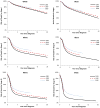Population-level trends in relative survival for cervical cancer
- PMID: 26210758
- PMCID: PMC4631664
- DOI: 10.1016/j.ajog.2015.07.012
Population-level trends in relative survival for cervical cancer
Abstract
Objective: While the last 3 decades have seen numerous advances in the treatment of cervical cancer, it remains unclear if population-level survival has improved. We examined relative survival, the ratio of survival in cervical cancer patients to matched controls over time.
Study design: Patients with cervical cancer diagnosed from 1983 through 2009 and recorded in the Surveillance, Epidemiology, and End Results database were examined. Survival models were adjusted for age, race, stage, year of diagnosis, and time since diagnosis. Changes in stage-specific relative survival for patients with cervical cancer compared to the general population matched by age, race, and calendar year were examined over time.
Results: A total of 46,932 patients were identified. For women with stage I tumors, the excess hazard ratio for women diagnosed in 2009 was 0.91 (95% confidence interval [CI], 0.86-0.95) compared to 2000, 0.81 (95% CI, 0.73-0.91) compared to 1990, and 0.75 (95% CI, 0.64-0.88) compared to 1983. For patients with stage III tumors, the excess hazard ratios for patients diagnosed in 2009 (relative to those diagnosed in 2000, 1990, and 1983) were 0.83 (95% CI, 0.80-0.87), 0.68 (95% CI, 0.62-0.75), and 0.59 (95% CI, 0.52-0.68). Similar trends in improved survival over time were noted for women with stage II tumors. There were no statistically significant improvements in relative survival over time for women with stage IV tumors.
Conclusion: Relative survival has improved over time for women with stage I-III cervical cancer, but has changed little for those with metastatic disease.
Keywords: cervical cancer; cervical carcinoma; relative survival; survival; trends.
Copyright © 2015 Elsevier Inc. All rights reserved.
Conflict of interest statement
The authors have no conflicts of interest or disclosures.
Figures


References
-
- Parkin DM, Bray F, Ferlay J, Pisani P. Global cancer statistics, 2002. CA Cancer J Clin. 2005;55:74–108. - PubMed
-
- Morris M, Eifel PJ, Lu J, et al. Pelvic radiation with concurrent chemotherapy compared with pelvic and para-aortic radiation for high-risk cervical cancer. N Engl J Med. 1999;340:1137–43. - PubMed
-
- Keys HM, Bundy BN, Stehman FB, et al. Cisplatin, radiation, and adjuvant hysterectomy compared with radiation and adjuvant hysterectomy for bulky stage IB cervical carcinoma. N Engl J Med. 1999;340:1154–61. - PubMed
-
- Rose PG, Bundy BN, Watkins EB, et al. Concurrent cisplatin-based radiotherapy and chemotherapy for locally advanced cervical cancer. N Engl J Med. 1999;340:1144–53. - PubMed
-
- Whitney CW, Sause W, Bundy BN, et al. Randomized comparison of fluorouracil plus cisplatin versus hydroxyurea as an adjunct to radiation therapy in stage IIB–IVA carcinoma of the cervix with negative para-aortic lymph nodes: a Gynecologic Oncology Group and Southwest Oncology Group study. J Clin Oncol. 1999;17:1339–48. - PubMed
Publication types
MeSH terms
Grants and funding
LinkOut - more resources
Full Text Sources
Other Literature Sources
Medical

